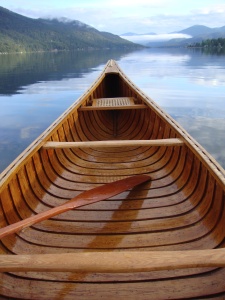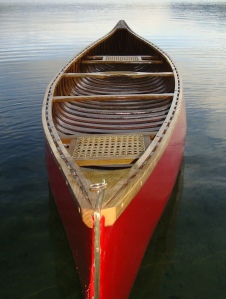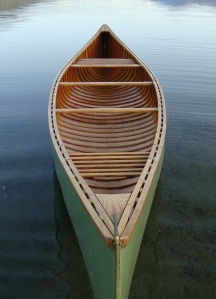Ogilvy, Bob Special, Pal and Prospector: These four canoes from the Chestnut Canoe Company set the standard for the industry and are still held up as icons more than thirty years after they went out of production.

The Chestnut Ogilvy – Although never as popular as the other three, fishing guides on the salmon rivers of New Brunswick helped create a working canoe that was unmatched for its purpose. They needed a river canoe they could stand up in all day long. They were often poling the canoe upstream through shallow rapids, so the canoe had to be stable and tough with a shallow draft so as to avoid many (but not all) of the rocks. They came in six models that ranged in length from 16’ to 26’ – real, honest working canoes.
 The 16’ model had a 36” beam and 13½” depth at the centre. The ribs were 3” wide and had only ½” space between them. This created what amounted to a double-planked hull. The rugged nature of the Ogilvy comes with a price in terms of weight. The 16’ has an average weight of 84 lbs. and a carrying capacity of 850 lbs. It has a flat-bottomed hull with full entry lines and moderate rocker in the ends. This makes for a canoe that is slow and steady. It is exactly what you need when working shallow, rapid rivers.
The 16’ model had a 36” beam and 13½” depth at the centre. The ribs were 3” wide and had only ½” space between them. This created what amounted to a double-planked hull. The rugged nature of the Ogilvy comes with a price in terms of weight. The 16’ has an average weight of 84 lbs. and a carrying capacity of 850 lbs. It has a flat-bottomed hull with full entry lines and moderate rocker in the ends. This makes for a canoe that is slow and steady. It is exactly what you need when working shallow, rapid rivers.
The Chestnut Bob Special – Before I talk about the canoe, I’d like to clarify the name. According to Roger MacGregor in his book “When the Chestnut was in Flower”, Harry and Will Chestnut were real history buffs. The telegraph code for the 15’ 50-Lb. Special was BOBS and made reference to Lord Roberts, a major figure during the Boer War in South Africa. Over the years, as this wide, light-weight canoe became more difficult to keep under the weight limit of 50 lbs (the average weight is 58 lbs. while the carrying capacity is 700 lbs), they changed the name. I have seen a variety of Chestnut catalogues call it “Bob’s Special” or “Bob Special”.
 Many outdoor enthusiasts were looking for a lightweight, stable canoe that would allow them to enjoy fly fishing or just a quiet paddle on the lake. With a 37”beam and 12½” depth at the centre, the Bob Special is very stable. At the same time, this canoe is surprisingly quick and maneuverable in the water. Unlike the Ogilvy, it has a shallow-arch to the bottom of the hull. This combined with moderate rocker and fine entry lines in the ends made it a pleasure to paddle.
Many outdoor enthusiasts were looking for a lightweight, stable canoe that would allow them to enjoy fly fishing or just a quiet paddle on the lake. With a 37”beam and 12½” depth at the centre, the Bob Special is very stable. At the same time, this canoe is surprisingly quick and maneuverable in the water. Unlike the Ogilvy, it has a shallow-arch to the bottom of the hull. This combined with moderate rocker and fine entry lines in the ends made it a pleasure to paddle.
The Chestnut Pal – It is no accident that this canoe was the one that Bill Mason turned to for use in most of his films. It is stable, yet quick; steady, yet agile. At 16’ long with a 36” beam, 12¾” depth at the centre, weight of 72 lbs. and a carrying capacity of 700 lbs, the Pal is as close to being a perfect recreational canoe as you will ever get.
 The bottom is a shallow-arch hull and tumblehome extends through the entire length of the canoe. The fine entry lines and moderate rocker make it very easy to paddle. In his film “Path of the Paddle: Solo Whitewater”, Bill Mason demonstrated very well that the Pal is not designed for Class 3 rapids. That said, it is a great general-purpose canoe and is the canoe of choice for many generations of canoeists – even if they do call it a Chestnut Prospector.
The bottom is a shallow-arch hull and tumblehome extends through the entire length of the canoe. The fine entry lines and moderate rocker make it very easy to paddle. In his film “Path of the Paddle: Solo Whitewater”, Bill Mason demonstrated very well that the Pal is not designed for Class 3 rapids. That said, it is a great general-purpose canoe and is the canoe of choice for many generations of canoeists – even if they do call it a Chestnut Prospector.  The Chestnut Prospector – This is the real deal – often copied, never matched. A quick search on the internet produces at least ten modern canoe companies with a “Prospector” in its catalogue. However, the Chestnut Canoe Company found the winning combination.
The Chestnut Prospector – This is the real deal – often copied, never matched. A quick search on the internet produces at least ten modern canoe companies with a “Prospector” in its catalogue. However, the Chestnut Canoe Company found the winning combination. They were made in five lengths from 14’ to 18’. The 16’ model has a 36” beam and a 14½” depth at the centre. It is a large-volume canoe (the 16’ model weighs 76 lbs. and carries 850 lbs.) that dances through rapids and laughs at rough water in big lakes. It is a fun canoe to paddle solo, but it really comes into its own when loaded for an extended wilderness trip. The hull has a generous arch to the bottom and although there is good tumblehome at the centre, the hull flares about 4’ from the ends in order to throw water away from the canoe while hitting big waves in rapid rivers.
They were made in five lengths from 14’ to 18’. The 16’ model has a 36” beam and a 14½” depth at the centre. It is a large-volume canoe (the 16’ model weighs 76 lbs. and carries 850 lbs.) that dances through rapids and laughs at rough water in big lakes. It is a fun canoe to paddle solo, but it really comes into its own when loaded for an extended wilderness trip. The hull has a generous arch to the bottom and although there is good tumblehome at the centre, the hull flares about 4’ from the ends in order to throw water away from the canoe while hitting big waves in rapid rivers.Read More
No comments:
Post a Comment